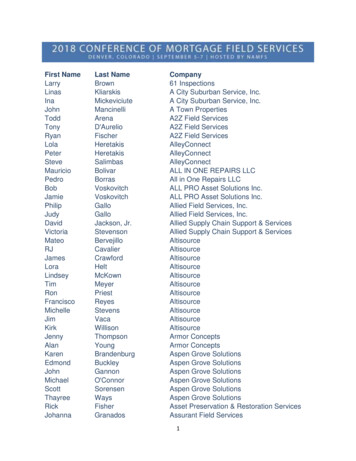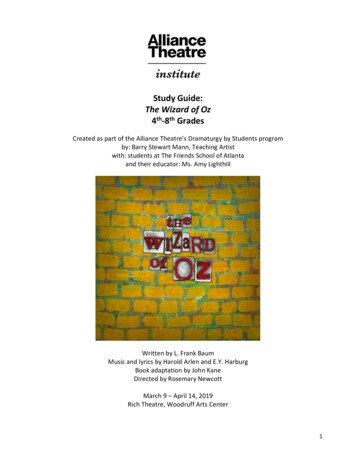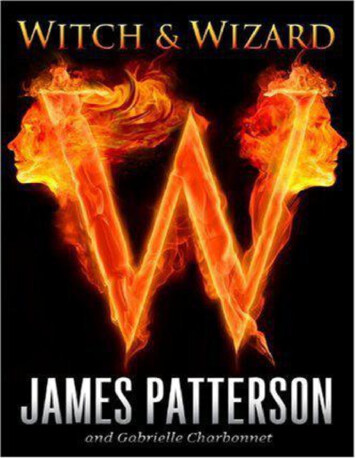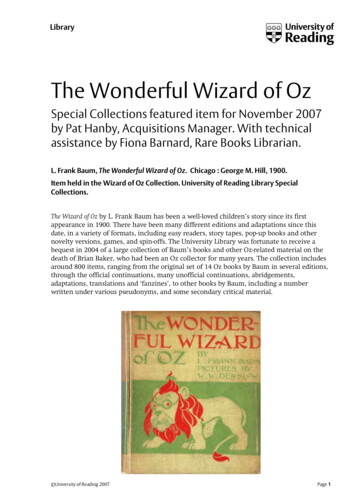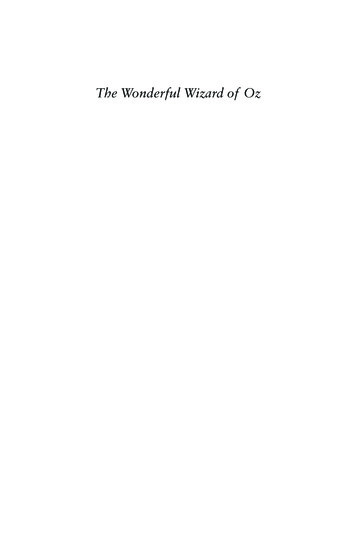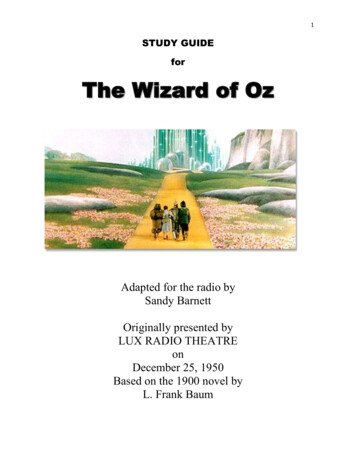
Transcription
1STUDY GUIDEforThe Wizard of OzRADIO THEATER FILGRAMMINGAdapted for the radio bySandy BarnettOriginally presented byLUX RADIO THEATREonDecember 25, 1950Based on the 1900 novel byL. Frank Baum
2GLOSSARY OF TERMSAesthetic Values – the lighting, costumes, sets, or other elements that make up theproduction’s sense of beauty and styleAntagonist – the person or circumstance causing the conflict for the protagonist; theantagonist can include nature, the universe, or even the protagonist himselfAntecedent Action – the events of the plot that took place before the play started and mustbe related to the audience to facilitate a proper understanding of the actionClimax – the highest point in the rising action of a drama; the “point of no return”Conflict – the main issue or problem that the play presents; without it, there is no dramaDialogue – conversation between two or more characters in a playFalling Action - the part of the plot that occurs after the climax has been reached and theconflict has been resolvedFoley effects – named for sound-effect artist Jack Foley, these are sound effects producedby sound-effect artists (“Foley artists”) with equipment and materials on stage or in thestudio, such as: doors with locks, breaking glass, knocks on doors, etc. These aredistinguished from recorded or digitally generated effects.Fourth Wall – the imaginary wall that separates the audience from the actors and allows usto believe that we are “looking in” on the actionGenre – a category of art characterized by a particular style, form, or contentEXAMPLES: Comedy, Tragedy, Mystery, Horror, etc.Inciting Incident – the event that occurs in a story that sets the rest of the events intoactionMonologue – one actor speaking at length either to him or herself, another character orcharacters, or the audience
3Musical Bridge – A musical that helps to carry one scene to the nextMusical Bed – Music that plays under the dialogue of a scene, often to increase dramaticeffect.Plot – specific moments of a story illustrated by the playwright and brought to life onstage; it must have a beginning, middle, and endingProtagonist – the person the story is about; the main characterResolution – how the play solves the conflict; it doesn’t always have to be “happily everafter”Rising Action - a series of mini-conflicts, climaxes, and resolutions that build toward themain climax of a storyStory – the entire chronological series of events that tell of a play’s happenings and eventsTheme – the main idea behind the play; there can be more than one (ex: jealousy, racism,love conquers all, etc.)
4Lux Radio Theatre, sometimes spelled Lux Radio Theater, a long-run classic radio anthologyseries, was broadcast on the NBC Blue Network (1934-35); CBS Radio(1935-54), and NBCRadio (1954-55). Initially, the series adapted Broadway plays[1] during its first two seasons before itbegan adapting films. These hour-long radio programs were performed live before studio audiences.The series became the most popular dramatic anthology series on radio, broadcast for more than 20years and continued on television as the Lux Video Theatre through most of the 1950s. Theprimary sponsor of the show was Unilever through its Lux Soap brand.Broadcasting from New York, the series premiered at 2:30 p.m., October 14, 1934, on the NBC BlueNetwork with a production of Seventh Heaven starring Miriam Hopkinsand John Boles in a full-houradaptation of the 1922–24 Broadway production by Austin Strong. The host was the show's fictionalproducer, Douglass Garrick (portrayed by John Anthony). Doris Dagmar played another fictionalcharacter, Peggy Winthrop, who delivered the Lux commercials. Each show featured a scriptedsession with Garrick talking to the lead actors. Anthony appeared as Garrick from the premiere 1934episode until June 30, 1935. Garrick was portrayed by Albert Hayes from July 29, 1935 to May 25,1936, when the show moved to the West Coast.[2]Cecil B. DeMille took over as the host on June 1, 1936, continuing until January 22, 1945. That initialepisode with DeMille featured Marlene Dietrich and Clark Gable in The Legionnaire and theLady.[1] On several occasions, usually when he was out of town, he was temporarily replaced byvarious celebrities, including Leslie Howard and Edward Arnold.Lux Radio Theatre strove to feature as many of the original stars of the original stage and filmproductions as possible, usually paying them 5,000 an appearance. In 1936, when sponsor LeverBrothers (who made Lux soap and detergent) moved the show from New York City to Hollywood, theprogram began to emphasize adaptations of films rather than plays. The first Lux film adaptationwas The Legionnaire and the Lady, with Marlene Dietrich and Clark Gable, based on thefilm Morocco. That was followed by a Lux adaptation of The Thin Man, featuring the movie'sstars, Myrna Loy and William Powell.Additional information available at: heatre/
5Lyman Frank Baum(May 15,1856 – May 6, 1919), was known by his penname L. Frank Baum. He was an Americanauthor primarily known for his children'sbooks, particularly The Wonderful Wizard ofOz. He wrote thirteen novel sequels, ninefantasy novels, and a host of other works.Baum grew up in the "Burned-Over District"of New York State. Baum was sent toPeekskill Military Academy at age 12, but heas a sickly child and possessed a daydreamingspirit. At 14, under severe discipline, hecollapsed with what appeared to be a heartattack. That was the end of his tenure inPeekskill. Baum never graduated anddisdained higher education. In his 20s, heraised chickens, wrote plays, and ran a theater(where he performed under the stage namesof Louis F. Baum and George Brooks.By 1882, He had married Maud Gage, a student at Cornell. Maud was Baum’s, “good friend andcomrade,” according to the dedication of Oz.On a trip to visit his brother-in-law in South Dakota, Frank decided to move his family to theMidwest at age 40, Frank threw himself into writing. In the spring of 1898, on scraps of raggedpaper, the story of The Wizard of Oz took shape. When he was done with the manuscript, heframed the well-worn pencil stub he had used to write the story, hoping he had written a worthyproject.Film PlotSet in Kansas in the early 1900s. Dorothy Gale lives with her dog Toto on her Aunt Em andUncle Henry’s farm. Dorothy and Toto get in trouble with their neighbor, Almira Gulch, whenToto bites her. However, Dorothy's family and the farmhands are all too busy to pay attention toher. Gulch arrives with permission from the sheriff to have Toto euthanized. He is taken away,but escapes and returns to Dorothy; she then decides to run away from home with Toto.They meet Professor Marvel, a phony fortune teller, who realizes Dorothy has run away andtricks her via his crystal ball into believing that her aunt is ill so that she must return home. Sheraces home as a tornado develops. Unable to get into the storm cellar, she seeks safety in herbedroom. A wind-blown window sash hits her head and she falls unconscious on her bed. Shebegins dreaming, seeing the house spinning in the air, In the storm outside the window she seespeople and animals flying by, including Gulch (still pedaling her bicycle), who transforms into acackling witch flying on a broomstick.
6The house crashes in Munchkinland in the Land of Oz, where the film changes to Technicolor.Glinda the Good Witch of the North and the Munchkins hail Dorothy as a heroine, as the househas landed on the Wicked Witch of the East, killing her, but leaving only her feet exposed. Hersister, the Wicked Witch of the West, appears to claim the magic ruby slippers worn on hersister's feet. Glinda transfers them to Dorothy's feet instead. The Wicked Witch of the Westswears revenge on Dorothy and Toto for her sister's death. Glinda tells Dorothy to follow theYellow brick road to the Emerald City, where the Wizard of Oz might be able to help her getback home.On her way to the Emerald City, Dorothy meets and becomes friends with the Scarecrow whowants a brain, the Tin Woodman who desires a heart, and the Cowardly Lion who is in need ofcourage. Dorothy invites each of them to come with her suggesting the Wizard may be able tohelp them as well. They finally reach the Emerald City. Inside, they are permitted to see theWizard (a large head surrounded by fire) who agrees to grant their wishes, but only after theybring him the Witch of the West's broomstick.On their adventure to the Witch's castle, the group passes through the Haunted Forest while theWitch views their progress through a crystal ball. She sends her winged monkeys to ambush thefour and capture Dorothy and Toto. Once at thecastle, the Witch tries to get the slippers offDorothy’s feet but is stopped due to a magicalelectric barrier. The witch threatens to killDorothy unless she gives up the slippers. Totoescapes, finds Dorothy’s three friends and leadsthem to the castle. After defeating three Guardsand stealing their uniforms, the Scarecrow, TinWoodman and Lion march inside and freeDorothy. The Witch and her guards discover theescape, chase the four friends and eventually trapthem. The Witch sets fire to the Scarecrow. In aneffort to save him, Dorothy splashes a bucket ofwater onto the flames also hitting the Witch. Thewater melts the witch. The guards rejoice thatshe is dead and give Dorothy the charredbroomstick in gratitude.Back at the Emerald City, the Wizard delays their requests to grant their obviously well-deservedrewards. As the group argues, Toto pulls open a curtain and exposes the "Wizard" as a normalmiddle-aged man who has been operating and controlling the image of the wizard; he admits tobeing a fake. But he gives the Scarecrow a diploma, the Lion a medal, and the Tin Man a tickingheart-shaped watch, telling them that these are mere symbols in recognition of qualities whichthey already possess. He then prepares to take Dorothy home in his hot air balloon, but Totojumps out of Dorothy’s arms to chase a cat, Dorothy follows, and the balloon leaves withoutthem.Glinda arrives and tells her that she can still return home by tapping her heels together threetimes and repeating, "There's no place like home". After saying a tearful goodbye to her friends,Dorothy taps her heels together and wakes up from her dream, surrounded by her Aunt Em,Uncle Henry, the farmhands, Professor Marvel and Toto.
7Dorothy feels alone. She runs away to save Toto and also to find a place she can feel safe andcall home. Her quest to find her way home drives the majority of the action from the moment ofher arrival in Oz. It’s that desire that sets her on the way to the Emerald City in the first place,which brings her to meet the Scarecrow, Lion, and Woodman. When Dorothy eventually returnsto the farm, she realizes that home is not a far off place, but is a feeling inside of her.TOPICS TO CONSIDER RADIO AS A MEDIUM When and where were the first radio broadcasts made?When and where was the first public radio broadcasting station?How did Radio change the way news and entertainment were delivered?During a Radio Play, listeners had to use their imagination to “fill in the blanks”.Do you think this was MORE effective or LESS effective as a method of entertainment?Why?PLACES IN THE PLAY Locate Kansas on a US map.What was Kansas like in the 1900’s?AFTER THE PLAYJust to see if you were paying attention. Were there characters in the movie that are not in the radio version?Who were they?Why do you think they were eliminated from the radio version?Where does the play take place? (Hint: There is more than one location)What were the jobs for everyone on the farm?First Impressions. What were your first impressions of the play?Did you relate to anyone in particular?Why or Why Not?Now let’s take your understanding a little further. Analyze the conflict(s) in Wizard of Oz? When does the climax occur? Are there smaller,more individual climaxes as the play develops? What is the resolution? Did the play endthe way you expected it to? If not, what did you think (or hope) was going to happen?Explain the meaning of the play’s title. Is this story really about the Wizard? If you had tocome up with an alternate title, what would it be?
8Let’s go even deeper. Think about the role of women in this production. What does this tell you about the viewof women during the time period? How is that similar or different from today?Did you feel the musical numbers were missed in the radio show? If so, how did you feelthe music helped you understand the feelings of the characters? Write your own songabout your place “over the rainbow”.Discuss the theme(s) in Wizard of Oz. Design and create a poster to publicize the play.What images and/or ideas do you think should be expressed?*Suggested Sunshine State StandardsLA 910.3.2.1; LA 111 2.3.2.1; TH D.1.4*Suggested National Core Arts StandardsTH.Re7.1.5; TH.Re7.1.4; TH.Re8.1.5; TH: Re9.1.6TH.Pr4.1.I; TH: Pr5.1.3; TH: Pr5.1.6; TH.Cn11.2.6Websites to Visit:History of Radio http://www.oldradio.org - a site that celebrates the history of radio includinga daily “This Day in Radio History”https://www.youtube.com/watch?v ahI4rajze2U - The Lux Radio Theatre’s presentation ofThe Wizard of OzRadio Plays tml - a site with suggestions on how studentscan create their own radio programshttp://www.latw.org/radio.html - LA Theatre Works, one of the nation’s most successful RadioTheater programshttp://www.radiolab.org - RadioLab, an NPR broadcast that blends science with storytellingMake Your Own Sound Effectshttp://www.epicsound.com/sfx/ https://www.youtube.com/watch?v azy-sound-effects-with-household- objectsTips for Using Sound Effects in the Classroomhttp://www.learnnc.org/lp/pages/5524?ref search
9After The Play - Student Response Sheet(Based on Bloom’s Taxonomy)(Do this quickly- as soon as possible after seeing the performance! Option: Take any oneor two questions and expound on them- use as many pages as necessary!)1. List some of the lines or images in the play that stick in your head. (These don’thave to be complete sentences; just a brainstorm of what “grabbed” you.)2. What questions do you have? (For the characters, for the playwright, for thedirector )3. What would you have changed? What didn’t you like? (Be specific.)4. What do you think some of the themes were?5. What do you think the playwright’s message is? Do you agree or disagree with it?Why?
1075 Weird, Wonderful Facts about The Wizard of OzIn honor of The Wizard of Oz‘s diamond anniversary, we present 75 fascinating, surprising, andsometimes a little unsettling, facts about the beloved film. Find more little-known facts about themaking of the movie, as well as rare test frames, film stills, and illustrations, in The Wizard ofOz: The Official 75th Anniversary Companion.1. The studio, Metro-Goldwyn Meyer, outbid 20th Century Fox for the movie rights. Fox hadwanted Shirley Temple to star.2. Mervyn LeRoy considered having a man play Toto.3. The cowardly lion’s costume was made of a real lion skin.4. The snow in the poppy scene was made of asbestos.5. Judy Garland had to wear a super-tight corset to make her figure seem younger.6. The Tin Man’s oil was actually chocolate syrup.7. Judy Garland’s daughter, Liza Minelli, was married to Jack Haley, Jr., the son of the actorwho played the Tin Man.8. Toto reportedly earned 125 per week of filming—but each Munchkin actor just 50.9. The horses in the Emerald City were colored with Jell-O, which they kept trying to lick off.10. Dorothy’s slippers in the book were silver.11. Toto was played by a female dog named Terry.12. Four sets of ruby slippers were used during filming.13. Margaret Hamilton’s copper-based green makeup could not be ingested, so she survivedentirely on liquids during filming.14. Billie Burke, who played Glinda the Good Witch, was 54 during filming, while MargaretHamilton, who played the Wicked Witch, was 36.15. Judy Garland originally wore a blonde wig and heavy makeup for filming, but producerssoon opted for a more natural look.16. “Over the Rainbow” was almost cut from the film for length reasons.17. The actress who voiced Disney’s Snow White made a voice cameo during the Tin Man’s “IfI Only Had a Heart” (She’s the one who says, ‘Wherefore art thou, Romeo?’)18. The ruby slippers were a size 5.
1119. The 1939 New York Times review of the film read, in part: “It is all so well-intentioned, sogenial and so gay that any reviewer who would look down his nose at the fun-making should bespanked and sent off, supper less, to bed.”20. Margaret Hamilton was a kindergarten teacher before becoming an actress.21. The film was nominated for six Oscars, but lost Best Picture to Gone with the Wind.22. The cowardly lion’s costume weighed around 100 pounds.23. Temperatures on set often soared about 100 degrees due to the lighting needed to shoot inearly Technicolor.24. Buddy Ebsen of The Beverly Hillbillies fame was cast as the Tin Man, but he had to bow outwhen he developed a severe allergic reaction to his silver paint. He had originally been offeredthe part of the Scarecrow.25. The tornado in the film was actually a 35-foot-long muslin stocking spun around with dustand dirt.26. In the movie, Dorothy clicks her ruby slippers and says, “There’s no place like home.” In thebook, she says to her magic silver shoes, “Take me home to Aunt Em!”27. The white in Dorothy’s dress was actually pale pink because it showed up better as white inTechnicolor.28. The Wicked Witch’s crystal ball was used as a prop in Boris Karloff’s The Mask of FuManchu.29. The Wicked Witch’s death certificate is dated May 6, 1938, the 20th anniversary of L. FrankBaum’s death.30. Producers ended up cutting many of the Wicked Witch’s scenes because they deemed themtoo scary for children.31. The ‘L’ in L. Frank Baum stands for Lyman.32. Baum published 17 sequels to The Wonderful Wizard of Oz, three of them posthumously.33. Two decades before making it big with The Wonderful Wizard of Oz, Baum was a breeder offancy chickens.34. The film won Oscars for best original score and best original song.35. Baum apparently invented the name ‘Oz’ when looking at an alphabetical filing cabinet label,‘O-Z.’36. The Munchkins have a collective star on the Hollywood Walk of Fame.37. Garland won as Oscar Juvenile Award for her role, which she later called the MunchkinAward.38. The Smithsonian exhibit housing Dorothy’s red slippers is so popular, the carpet in front ofthe slippers has been replaced numerous times due to wear and tear.PubMatic ad tag (JavaScript): Parade 300x250 BTF http://www.parade.com 300 x 250Sidekick39. Judy Garland fell in love with Terry, the dog who played Toto, and wanted to adopt her, butTerry’s owner wouldn’t give her up.40. The Munchkins were played by a troupe called the Singer Midgets, named for their managerLeo Singer. They were from Europe, and “a number of the Munchkins took advantage of the tripto immigrate and escape the Nazis,” according to the Internet Movie Database. Their voices weredubbed because many of them couldn’t speak English very well.41. Professor Marvel never returned Dorothy’s photo of Auntie Em.42. The fire that blazes out from Dorothy’s shoes when the Witch tries to touch them wasactually apple juice spraying out of them, sped up on film.43. The Cowardly Lion was originally going to be played by the real-life MGM lion.44. The Scarecrow’s face prosthetics left deep groves in actor Ray Bolger’s face that reportedlytook more than a year to disappear.
1245. Terry the dog was scared of the steam that came out of the Tin Man’s hat.46. In an oft-told story from the set, Judy Garland couldn’t stop giggling during the scene whereDorothy slaps the Cowardly Lion. Director Victor Fleming apparently took Garland aside andslapped her, after which she nailed the scene in one take.47. The yellow brick road originally showed up green in Technicolor, so it had to be repainted.48. Charley Grapewin, the actor who played Uncle Henry, began his career in the late 19thcentury as a circus trapeze artist, and also appeared as Grandpa Joad in 1940’s The Grapes ofWrath.49. Disney wanted to make The Wizard of Oz, but MGM owned the rights to the book.50. Several actors playing Winged Monkeys in the forest were injured when the wiressuspending them above the sound stage snapped, sending them falling several feet.51. Contrary to popular myth that she was dubbed, Billie Burke (Glinda the Good Witch) did herown singing for the film.52. Glinda’s gown was actually recycled from the 1936 movie San Francisco.53. L. Frank Baum drew inspiration for the story from his difficult childhood during a drought inSouth Dakota.54. Baum strongly supported women’s suffrage.55. MGM paid 75,000 for the film rights to Baum’s book, an astronomical amount at the time.56. The Flying Monkeys and the Witch’s castle guards wore the same uniforms.57. Judy Garland’s hair changes length throughout the film.58. Humorist Ogden Nash wrote a screenplay for the film that was never used.59. Dorothy was named after Dorothy Louise Gage, a niece of L. Frank Baum who died as ababy.60. Director Victor Fleming was reportedly pro-Nazi and opposed America entering World WarII.61. Margaret Hamilton suffered severe burns during the scene in which she vanishes in a cloudof smoke (her skin makeup ignited).62. Hamilton recovered, though refused to do any more scenes involving fire.63. Besides fiction, L. Frank Baum wrote widely on various non-fiction topics, including stampcollecting and store decoration guides.64. Production costs for the film were around 2,777,000, an incredibly high sum at the time.65. A pair of real ruby slippers was made in 1989 to commemorate the film’s 50th anniversary.They’re reportedly worth around 3 million.66. A guard accidentally stepped on Terry the dog during filming and broke her foot.67. During filming, most of the actors arrived on set at 4 or 5 a.m. and finished at 7 or 8 p.m.68. The Tin Man’s aluminum-based makeup gave actor Jack Haley a severe eye infection.69. The actress who played Auntie Em, Clara Blandick, committed suicide in 1962 after battlingdebilitating arthritis and impending blindness.70. The film has a 99 percent positive critical rating on Rotten Tomatoes.71. There were two people on set whose sole job it was to dry out to the Cowardly Lion costumeevery night. It apparently “reeked” because Bert Lahr sweated so much in the 90 to 100 poundcostume under the 100 degree lights.72. The actor who played the Coroner of Munchkinland was once the shortest licensed pilotduring World War II.73. The Wizard of Oz was the first MGM film to be televised on a national network.74. An early design of Dorothy’s ruby slippers had curled-up toes.75. The ruby slippers on display in the Smithsonian are mismatched.
13Thanks to the following trivia sources: Flavorwire, Buzzfeed, The Guardian, HarperCollins,IMDB, Listverse, Backstage at the GlobeStudy Guide resources:Chloe Schama, SMITHSONIAN.COMJUNE 25, 2009Theatre Institute at Sage Colleges.
comrade,” according to the dedication of Oz. On a trip to visit his brother-in-law in South Dakota, Frank decided to move his family to the Midwest at age 40, Frank threw himself into writing. In the spring of 1898, on scraps of ragged paper, the story of The Wizard of Oz
